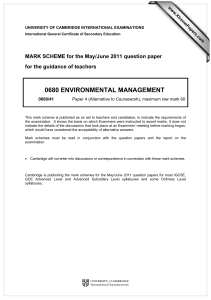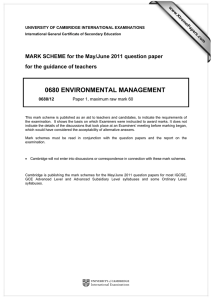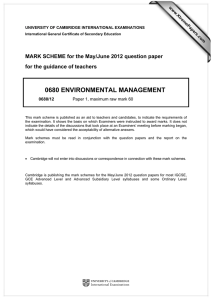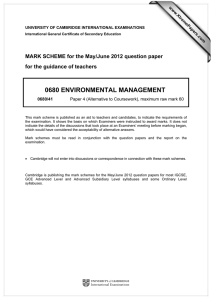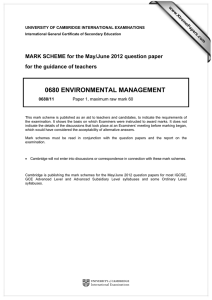0680 ENVIRONMENTAL MANAGEMENT MARK SCHEME for the May/June 2012 question paper
advertisement
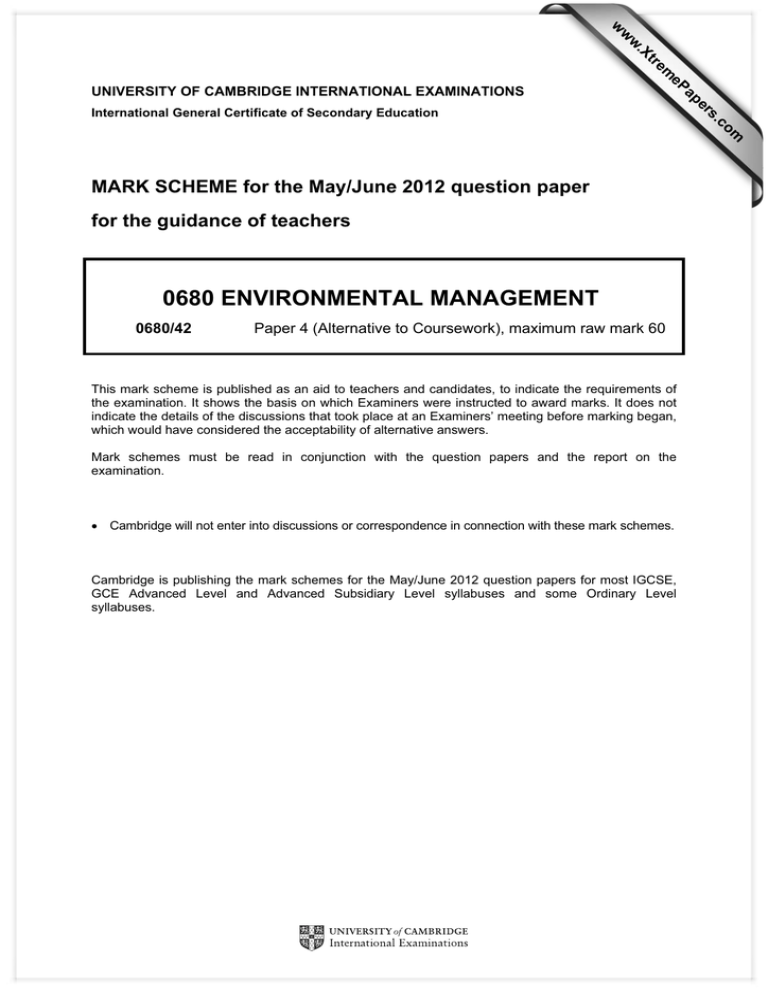
w w ap eP m e tr .X w UNIVERSITY OF CAMBRIDGE INTERNATIONAL EXAMINATIONS for the guidance of teachers 0680 ENVIRONMENTAL MANAGEMENT 0680/42 Paper 4 (Alternative to Coursework), maximum raw mark 60 This mark scheme is published as an aid to teachers and candidates, to indicate the requirements of the examination. It shows the basis on which Examiners were instructed to award marks. It does not indicate the details of the discussions that took place at an Examiners’ meeting before marking began, which would have considered the acceptability of alternative answers. Mark schemes must be read in conjunction with the question papers and the report on the examination. • Cambridge will not enter into discussions or correspondence in connection with these mark schemes. Cambridge is publishing the mark schemes for the May/June 2012 question papers for most IGCSE, GCE Advanced Level and Advanced Subsidiary Level syllabuses and some Ordinary Level syllabuses. om .c MARK SCHEME for the May/June 2012 question paper s er International General Certificate of Secondary Education Page 2 Mark Scheme: Teachers’ version IGCSE – May/June 2012 Syllabus 0680 Paper 42 General notes Symbols used in Environmental Management mark schemes. / separates alternatives for a marking point – other valid ways of expressing the same idea are also credited ; separates points for the award of a mark [3] indicates the number of marks available [max 3] the number shows the maximum number of marks available for the question where there are more marking points than total marks available [max 3] when part of the marks of a question must come from part of the mark scheme, this is indicated by non-bold marks showing the internal maxima for different parts of the question these non-bold marks are also used to show marks for bands where banded mark schemes are used italic indicates that this is information about the marking points and is not required to gain credit italic text is also used for comments about alternatives that should be accepted, ignored or rejected ora or reverse argument – shows that an argument from an alternative viewpoint will be credited AW alternative wording, sometimes called ‘or words to that effect’ – AW is used when there are many different ways of expressing the same idea ( ) the word / phrase in brackets is not required to gain marks but sets the context of the response for credit e.g. (nuclear) waste – nuclear is not needed but if it was described as a domestic waste then no mark is awarded volcanic underlined words – the answer must contain exactly this word ecf error carried forward – if an incorrect answer is given to part of a question, and this answer is subsequently used by a candidate in later parts of the question, this indicates that the candidate’s incorrect answer will be used as a starting point for marking the later parts of the question © University of Cambridge International Examinations 2012 Page 3 1 Mark Scheme: Teachers’ version IGCSE – May/June 2012 Syllabus 0680 Paper 42 (a) (i) ref. to eutrophication; nutrients / named nutrients increase; algae grow / bloom; block light from plants; so less / no photosynthesis; death of algae / plants; decomposed by bacteria / increase in bacteria; less oxygen available / use up oxygen; for respiration / decomposition; less fish / fish die; detail e.g. ref. nitrate decreasing or phosphate ions increasing; (ii) yes with some supporting comment; content of supporting comment – ref. rise of phosphate; BOD; numbers of fish; numbers of fish species; (ignore pH) [max 5] [1] [max 2] [max 3] (b) pull factors such as jobs / (better) income / AW; push factors such as poverty / unemployment / crop failure / better services / infrastructure / natural disaster such as flood or drought; [max 1] (c) (i) 100 (%); [1] (ii) source of protein / minerals / named mineral e.g. calcium / phosphate / vitamin D / omega oil / fish oil / essential oils; (d) (i) orientation x-axis is time in days from start / AW, y-axis is average weight per fish in grams; both axes labelled as for orientation; plots;; one error max 1 for plots accept bar charts [1] [4] (ii) 70 (g) / half / double / 50% / difference quoted; [1] (iii) similarity both increase / AW; difference increase at different rates / AW; [2] (iv) pollution with household waste / industrial waste / heavy metals / toxins / poisons / pesticides; poor quality food / not enough food / nutrients / less or little oxygen; accept converse arguments for river water [max 1] (e) risk of food poisoning / AW; toxic effects of heavy metals / organic compounds; ref. to (pathogenic) bacteria / virus; Reject pollution/waste unqualified © University of Cambridge International Examinations 2012 [1] Page 4 2 Mark Scheme: Teachers’ version IGCSE – May/June 2012 (a) (i) (2000 ÷ 25 =) 80 (buckets);; Syllabus 0680 Paper 42 if answer incorrect, credit correct working to max 1 [2] (ii) use of renewable wooden boats / reuse of rice bags / waste materials for sail / AW; sand replenished by river system / AW; collection unlikely to exceed replenishment; mechanical dredging may do more damage / ora; AVP; e.g. no fuel burnt / no oil released / no emissions of greenhouse gases; [max 2] (iii) government not making any money; collect no tax from extraction / AW; no selling of licences; government wants to control resource / environment; ref. to worker safety; [max 2] (b) (i) best and worst months named December / January AND June; reasons least rainfall / fewest wet days AND highest rainfall / most wet days; [2] (ii) lack of room; cash flow / too much money needed to hold / produce stock / AW; fear of being stolen; limited water supply; investment too expensive / too much money needed for machinery; too much money for sand / cement / materials; accept ora [2] (iii) hollow insulation; ref. to easier transport / weight; waste rice husks good use of agricultural waste; no disposal problem of rice husks; rice husks a cheap resource; accept in either, once only less materials / sand / cement used (per block); lower cost of sand; lower cost of cement; © University of Cambridge International Examinations 2012 [max 3] Page 5 Mark Scheme: Teachers’ version IGCSE – May/June 2012 Syllabus 0680 Paper 42 (c) (i) ref. to banks holding water in field; ref. to ditches to channel water / AW; [max 1] (ii) add humus (to soil); release nutrients to soil; save on cost of fertiliser; ref. to improvement of soil conditions / soil drainage / soil moisture (retention) / soil structure; ref. to farmers making more money; ignore ref. to animal fodder [max 2] (iii) ref. mosquitoes; (mosquitoes) breed in water; (mosquitoes) bite an infected person; carry malaria to humans; when they bite an uninfected person; malaria does not kill mosquitoes / other biological detail about infection in mosquito; farmers cannot afford / access, drugs / mosquito nets; [max 3] 3 (a) good layout (three alternative answers in at least one question); three questions to find out about: crop damage; crop yields; costs; selling price; profit; AVP; [max 1] [max 3] [max 4] (b) (i) 81390; 2.6; [2] (ii) table drawn (using lines to distinguish cells) / accept an appropriate graph; data in rank order of metres / data in rank order of pH; headings distance/m / distance (m) / distance in metres / AW AND pH (ignore units in table); [3] (iii) as distance increases so the pH decreases / AW / ora; [1] (c) (i) same source of seed / growing temp / humidity / wind conditions / light (intensity) / volume of soil / age of seed / AVP; accept pH of soil, reject similar weather (ii) yes with ref. to growth rate reduced; for all cement samples / AW; ref. to 2 cm reduction; reduced photosynthesis / transpiration / gas exchange; no with ref. to growth not very different / both grew more than 10 cm; [1] [1] [max 2] [2] (iii) stem length / distance between leaves / number of leaves / number of flowers / time of flowering; mass / weight of spinach ; [max 1] © University of Cambridge International Examinations 2012 Page 6 Mark Scheme: Teachers’ version IGCSE – May/June 2012 Syllabus 0680 Paper 42 (d) developments control of cement dust; more crops; mixed cropping; comment on supply of vitamins; sustainable block production using rice husks; allow some / controlled mining for wealth of nation / employment / reduce poverty; AVP; [max 5] restrictions: development of more cement factories; control of sawmill waste into rivers; alternative uses e.g. fuel; strict controls on mining to prevent environmental damage; ref. to family planning; AVP; © University of Cambridge International Examinations 2012 [max 5] [max 7]
